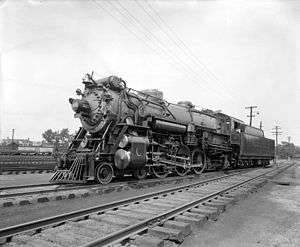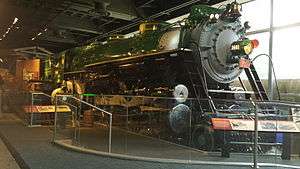Southern Railway Ps-4 class
| Southern Railway class Ps-4 4-6-2 | |||||||||||||||||||||||||||||||||||||||
|---|---|---|---|---|---|---|---|---|---|---|---|---|---|---|---|---|---|---|---|---|---|---|---|---|---|---|---|---|---|---|---|---|---|---|---|---|---|---|---|
 ALCO Richmond built Ps-4 No. 1396 built in 1926. | |||||||||||||||||||||||||||||||||||||||
| |||||||||||||||||||||||||||||||||||||||
| |||||||||||||||||||||||||||||||||||||||
| |||||||||||||||||||||||||||||||||||||||
| |||||||||||||||||||||||||||||||||||||||
The Ps-4 was a class of 4-6-2 steam locomotives built for the Southern Railway, as well as its subsidiaries, the Alabama Great Southern Railroad and the Cincinnati, New Orleans and Texas Pacific Railway. The engines are notable for their green with gold trim liveries, and have been regarded by Smithsonian curator John H. White, Jr. as being "among the most celebrated passenger locomotives operated in the United States...."
Development
In 1923, the Southern Railway began placing an order for new locomotives of the 4-6-2 Pacific design capable of handling up to fourteen cars over a moderate grade, as well as top speeds of 80 miles per hour (130 km/h).[1] The first group of locomotives were built by the American Locomotive Company at their Schenectady Works in that year, with twenty six delivered to the Southern, numbered 1366-1392; as well as five for the Cincinnati, New Orleans and Texas Pacific, numbered 6471-6475; and four for the Alabama Great Southern, numbered 6684-6687. These locomotives were derived from the standard USRA Light Pacific design, but had notable differences based on the Southern's needs.[1] The Ps-4s had smaller driving wheels (73 inches vs. 79 inch USRA design), as well as larger, more spacious cabs, and featured single unit 3-B Worthington feedwater heaters under the left-hand running boards.[2]
The queens of steam locomotives
In 1925, Southern Railway president Fairfax Harrison traveled to the United Kingdom, where he admired the country's London and North Eastern Railway's use of green-painted steam locomotives.[1] In 1926, Harrison's trip had inspired the appearance of the second order of Ps-4s, which was being built by ALCO's Richmond Works at the time.[1] These Ps-4s were painted in Sylvan green with gold leaf trimming and lettering.[1] This order consisted of eleven engines for the Southern, numbered 1393-1404; seven for the Cincinnati, New Orleans and Texas Pacific, numbered 6476-6482; and four for the Alabama Great Southern, numbered 6688-6691. Aside from the paint scheme, which would soon be applied to all of Southern's passenger locomotives, the second order had other notable differences. They featured an Elesco feedwater heater rather than the Worthington heaters of the previous order, with the former placed on top of the smokebox between the stack and bell instead of under the running boards as the latter were placed. The second order also had larger tenders better suited for long-distance passenger runs, with three-axle bogies and 14,000-gallon water capacity, versus the two-axle bogie, 10,000-gallon standard USRA tender design of the first order.[1]
The final Ps-4s were built in 1928 by the Baldwin Locomotive Works, consisting of only five engines for the Southern, numbered 1405-1409. These engines featured smaller tenders than the second order, but still larger than those of the first order, featuring two-axle bogies and a 12,000-gallon capacity. They also had Walschaerts valve gear instead of the Baker valve gear on previous orders. The final engine of the series, number 1409, featured an extended smokebox with a Coffin feedwater heater. This heater was fitted on an experimental basis and was later removed in favor of the Worthington heaters used in the first order.
In 1941, Southern Ps-4 No. 1380 was given bullet-nose streamlining designed by Otto Kuhler for use on the railway's Tennessean service, which operated between Washington, DC, and Monroe, Virginia, connecting in the latter to the Norfolk and Western Railway, who had assigned its streamlined J class engines to its connecting lines. When the Tennessean was dieselized, 1380 joined the remainder of the Ps-4s assigned elsewhere on the road until her retirement in 1953, though it retained its streamlining.
Service
The Ps-4 locomotives were assigned to many of the Southern's most famous passenger trains, including the Crescent, Piedmont Limited, Aiken-Augusta Special, and the Birmingham Special. The Cincinnati, New Orleans and Texas Pacific assigned the engines to their Royal Palm, Ponce de Leon, Queen & Crescent, and Florida Sunbeam trains, among others.
In 1941, the Southern began to retire the Ps-4s in favor of diesels. However, due to the onset of World War Two, the railroad was unable to purchase additional diesel locomotives, and so opted to continue to employ the Ps-4s for the duration of the war. After the war, the railroad resumed dieselizing its trains, and the Ps-4s were largely out of service by 1948. Between 1949 and 1953, the Southern had scrapped all but one of the Ps-4s.[3]

The sole preserved Ps-4 is number 1401 of the 1926 order, which was saved in 1953 by the railroad's outside legal counsel and later president Graham Claytor, who requested that the engine be donated to the Smithsonian Institution. The Southern Railway management obliged, and the engine was placed in storage while the institution prepared its new home. In 1961, the engine was placed inside the Smithsonian's newly built National Museum of American History which opened in 1964. The engine currently remains displayed in this museum.
See also
References
| Wikimedia Commons has media related to Southern Railway class Ps-4. |
Bibliography
- Drury, George (2015). Guide to North American Steam Locomotives, Revised Edition (2nd ed.). Kalmbach Publishing. ISBN 978-1627002592.
Further reading
- Prince, Richard E. (1970). Steam Locomotives and Boats: Southern Railway System (2nd ed.). ISBN 978-0960008841.
